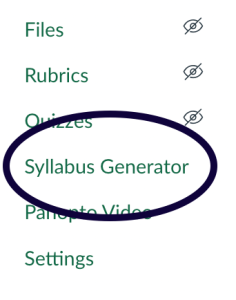10 Developing Your Syllabus
In this chapter, we will explore the significance of a well-constructed syllabus with a structured schedule in guiding students through their course. You will have access to templates and guides to support the development of your syllabus. In addition, we will explore the role your syllabus plays in setting the tone for a course and why this is important.
Syllabus
Importance of a Structured Syllabus
A structured syllabus serves as a blueprint for the course, providing students with a clear outline of what to expect and what is expected of them. It not only communicates the learning outcomes and course requirements but also sets the tone for the learning environment. By presenting a structured schedule, students are equipped with the necessary tools to organize their time effectively and prioritize their tasks.
The Academic Courses Policy
The USask Academic Courses Policy (ACP) lists several required items that must be included in your syllabus. Your college or department may have requirements as well, but your syllabus must at least include the items in the ACP.
The ACP also limits what changes may be made to a syllabus once students have it as the university considers it a contract.
The Syllabus Generator
 To help you create a clear and well-structured syllabus USask has a Syllabus Generator tule embedded within each Canvas course.
To help you create a clear and well-structured syllabus USask has a Syllabus Generator tule embedded within each Canvas course.
The Syllabus Generator also includes additional recommended items that may be useful for making sure your syllabus is clear and sets the tone you hope to set for the class.
Your college or department may have a custom version of the Syllabus Generator for you to use.
In addition, a Word version template containing all of the required and recommended components, as well as a guide to creating your syllabus can be found on the GMCTL website.
Designing a Syllabus to Set the Tone for the Class
Your syllabus is often the first glance students get of the course and the instructor. They will likely see it in Canvas before the first in-person or virtual session. The Syllabus Guide and the Syllabus Generator both contain suggested language for each item in the syllabus (the same suggestions appear in both), but some things you may consider when creating your syllabus are:
- Add a brief biography about yourself written in first-person. Who are you? Why do you teach in this discipline?
- Use language that is more welcoming than punitive. Just because it is a contract doesn’t mean it needs to read like one.
- How and when can students reach you for help? If you want them to come to you, make sure you convey that they are welcome to contact you.
Should you require additional support in implementing these strategies, the Gwenna Moss Centre for Teaching and Learning is available to assist you.
